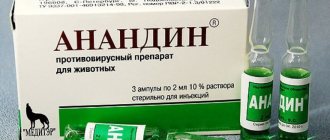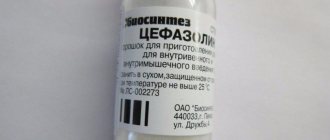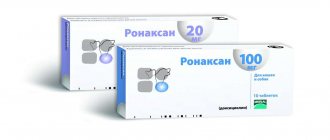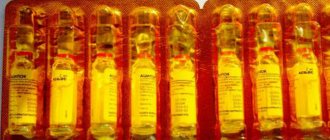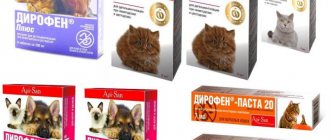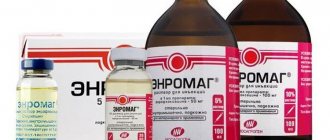What is treated with Cefotaxime?
Cats, like any pet, sometimes get sick. This happens more often with animals that are outdoors. They have diseases that people also get, but there are exclusively cat diseases. In most cases of infection in a pet, doctors prescribe Cefotaxime. Instructions for use
"Cefotaxime" for cats describes the use of the drug for infectious diseases:
- respiratory organs;
- organs of the excretory system;
- organs of hearing and smell;
- brain;
- bone and muscle tissue;
- organs of the digestive system;
- organs of the reproductive system;
- wounds and burns.
Important! Treatment with Cefotaxime should only be carried out strictly as prescribed by a veterinarian.
Reviews from owners and veterinarians
According to reviews from Maria, the owner of a fifteen-year-old shepherd dog, Ceftriaxone helped save an animal suffering from pancreatitis. The disease gave complications and was difficult. The pet practically did not move and refused to eat food. But after completing a ten-day course of antibiotic treatment, Lari, that’s the dog’s name, felt much better and began to recover.
Oksana also approved the effect of the medicine. A woman was walking her dog and it injured its paw. The wound began to fester. During the examination, the doctor prescribed Ceftriaxone. After a five-day course, the wound began to heal quickly. The owner notes that the injections were tolerated normally. The dog did not try to escape, but only whined.
Vladimir, a veterinarian with eight years of experience, also spoke positively about the drug. The man clarifies that Ceftriaxone always works well against bacteria and is considered one of the most effective antibiotics.
Application procedure
Cefotaxime is given to cats by injection. If you take it orally, it is not absorbed. The release form of the drug is powder. Before use, it should be diluted - prepare a solution for injection. Dilution is carried out with Novocaine.
Lidocaine cannot be used as an anesthetic for cats.
When preparing the solution take:
- "Cefotaxime" - 1 gr.
- "Novocaine" - 2 ml.
- Water for injections – 2 ml.
You can give a Cefotaxime injection to a cat by intramuscular injection or inject it intravenously using a catheter. Only a doctor should give an intravenous injection.
The dosage of Cefotaxime for a cat is calculated taking into account the pet’s body weight:
- if the cat weighs less than 2 kg - 0.5 ml of antibiotic solution;
- cats weighing more than 2 kg - 1 ml of Cefotaxime solution.
A cat should be injected with Cefotaxime once a day, but often the doctor advises dividing the required volume into several doses. Treatment lasts from 7 to 10 days, it all depends on the clinical picture of the disease. Even if the signs of the disease have gone away and the pet’s health has improved, the injections must continue to be given in the same dose. The entire course prescribed by the doctor must be completed in full.
When treating a cat with Cefotaxime, strictly follow the dosage prescribed by your doctor.
In what form is Cefotaxime produced and what composition does it have?
Release forms
The antibiotic is sold in hermetically sealed vials. It is produced exclusively in the form of a white powder intended for the preparation of a solution for injection. In pharmacies, the drug is sold individually or in cardboard packaging of 5, 40 and 50 bottles. The medicine is not available in tablets.
Each ampoule contains 0.5 or 1.0 grams of the active ingredient (cefotaxime sodium salt).
How to make an antibiotic solution at home
It is best if you are given antibiotic injections at a medical facility or by a visiting health worker, but this is not always possible. You can learn to prepare your own solution for injections and do them yourself. There's nothing complicated about it.
Cefotaxime injections are quite painful, so they are diluted with an anesthetic liquid - lidocaine. To prepare a solution for one injection you will need:
- 2% lidocaine solution - 2 ml;
- Water for injections - 2 ml;
- Ampoule of Cefotaxime - 1.0 g;
- Disposable syringe - 5 ml;
- Medical alcohol;
- Sterile cotton wool;
- File for ampoules, if water for injection and lidocaine are in glass ampoules.
First, wipe your hands, all ampoules and vials with a cotton swab soaked in alcohol or an alcohol-containing liquid, for example, boric alcohol. Using a glass file, we file down the ampoules with water and lidocaine, open them and place them on the table. We bend the valve of the antibiotic bottle and also wipe the rubber cap with alcohol. Next, we take the syringe out of the package without touching the tip of the needle with our hands, put it on the spout, take the ampoule with lidocaine and draw its contents into the syringe. Then we stick the needle into the rubber stopper of the medicine bottle and squeeze out the painkiller there. We do the same with water for injection.
Remember that between manipulations the syringe is placed on the table so that the needle is in the air and does not touch any objects or the table itself. Now the bottle of antibiotic must be shaken thoroughly so that all the ingredients are mixed until smooth. Next, we take the syringe again and draw the resulting solution into it, shake it a little so that all the air in it comes to the spout, and slowly release it by pressing the syringe plunger. Once the air has been released, you can give the injection.
Contraindications
Cefotaxime is a fairly strong antibiotic. Therefore, it is prescribed only after tests have been carried out and the animal has been examined. After all, erroneous use can cause side effects or even the death of your pet. Like any drug, it has a certain list of contraindications for which the use of Cefotaxime is strictly prohibited :
- with kidney failure;
- for liver diseases;
- during pregnancy and lactation;
- kittens;
- with peptic ulcer of the stomach or intestines;
- with intolerance to antibiotics, penicillin.
Interaction with medications
When Cefotaxime is combined with loop diuretics, a nephrotoxic effect develops. When using an antibiotic simultaneously with nonsteroidal anti-inflammatory drugs and antiplatelet agents, internal bleeding occurs.
If taking an antibiotic coincides with therapy with antithrombotic drugs, the risk of bleeding increases several times.
Its use is also not advisable if the patient is already receiving therapy with aminoglycosides or polymyxin.
B or loop diuretics, since such a tandem often causes renal failure.
Side effects
The drug "Cefotaxime", like "Ceftriaxone", is often prescribed to cats and dogs in veterinary practice. But it is not suitable for all animals. It is not uncommon for cats to experience problems with the functioning of individual organs or even systems when using it. Side effects after taking the medicine may occur :
- malfunction of the digestive system (vomiting, flatulence, constipation);
- signs of allergies (urticaria);
- breathing problems;
- malfunctions of the liver and kidneys;
- changes in blood composition;
- difficulty urinating;
- manifestations of signs of fungal infection;
- dizziness, headache.
Irritation may occur at the injection site. There is an increase in body temperature.
To avoid any unforeseen situations when treating a cat, you must completely follow the doctor’s instructions. And if even minor symptoms of side effects appear, stop taking the drug and immediately contact your veterinarian.
In what cases is Cefotaxime contraindicated?
Injections of the drug are contraindicated for:
- Intolerance to Cefotaxime, the occurrence of allergic manifestations;
- First trimester of pregnancy;
- Bleeding;
- Enterocolitis;
- The presence of acute colitis.
The medicine is used with caution in the treatment of newborns and patients with severe pathologies of the liver and kidneys.
Use during pregnancy and breastfeeding
For pregnant women, Cefotaxime injections are prescribed for the presence of various infections in the second and third trimesters of pregnancy. In the first case, the use of the medicine is strictly prohibited, since during this period all the vital organs of the fetus are formed.
If injections are prescribed to a nursing mother, then she should stop breastfeeding.
Pregnant women are allowed to use the drug only strictly as prescribed by the treating doctor and under his supervision.
Use of Cefotaxime in childhood
As mentioned above, Cefotaxime injections can be used in the treatment of even infants, but it is worth remembering that the drug lingers longer in a child’s body than in an adult, so treatment should be carried out with great caution and strictly under the supervision of a pediatrician. Under no circumstances should you self-medicate. Especially when it comes to your infant.
What side effects may occur when using an antibiotic?
Cefotaxime injections can cause side effects that manifest themselves as:
- Allergic manifestations (rashes, urticaria, fever, Quincke's edema, etc.);
- Vomiting, nausea, abdominal pain, stool disorders, jaundice, colitis, etc.;
- Changes in blood composition;
- Headaches;
- Pain at the injection site;
- Interstitial nephritis;
- Hemolytic anemia.
If side effects occur, you should stop using the drug and seek advice from a specialist.
A drug overdose can manifest itself:
- Cramps;
- Tremor;
- Fever;
- Encephalopathy (with kidney disease);
- Temporary hearing loss;
- Discoordination of movements.
In case of drug poisoning, you should immediately seek medical help.
Composition and properties
The pharmaceutical drug Cefotaxime is sold in the form of a solution for parenteral administration containing the active ingredient cefotaxime anhydrous. This substance has a pronounced antibacterial effect, which consists in disrupting the synthesis of the cell walls of the pathogenic microorganism, after which they lose the ability to reproduce and die. "Cefotaxime" is active against gram+ and gram-bacteria, strains of Pseudomonas aeruginosa, acenitobacter, and Helicobacter pylori.
Cefotaxime injections
- Claforan;
- Cefantral;
- Cephosin.
Price
Average price online*, 990 rub. (50 bottles 1g)
Where can I buy:
Instructions for use
Cefotaxime is a semisynthetic cephalosporin antibiotic of the third generation. It has a wide spectrum of activity. The medication is produced in the form of a powder for the preparation of a solution for injection.
Indications
The antibiotic is prescribed to treat diseases caused by bacteria sensitive to the drug, including infections:
- spinal cord and brain;
- musculoskeletal system;
- skin;
- respiratory organs;
- ear, throat, nose (otitis externa, labyrinthitis);
- genitourinary system, including gonorrhea;
- abdominal cavity;
- soft tissues;
- blood poisoning;
- tick-borne borreliosis;
- inflammation of the endocardium;
- salmonellosis;
- developing against the background of decreased immunity.
It is also prescribed to reduce the risk of bacterial infection after surgical treatment.
Dosage regimen
The medication is injected into a vein (bolus or drip) and into the muscle.
The antibiotic is prescribed to adults and children over 12 years of age whose weight exceeds 50 kg, in the following doses:
| Diseases | Dosage |
| uncomplicated infections, diseases of the urinary system | into the muscle and into the vein after 8-12 hours, 1 g. |
| gonorrhea | into the muscle 1 time at a dose of 1 g. |
| moderate infections | IM, IV 1 g or 2 g 2 times a day. |
| dangerous infections, for example, meningitis | 2 g into a vein at intervals of 4-8 hours. |
| for prevention | before surgery 1 time 1 g during the administration of anesthesia, if necessary, repeated administration after 6-12 hours. |
| during caesarean section | while applying a clamp to the umbilical vein, IV in a dosage of 1 g, then after 6 and 12 hours another 1 g. |
The highest daily dosage is 12 g. In case of kidney pathology (glomerular filtration rate no more than 20 ml/min), the daily dosage is reduced by 2 times. The duration of therapy is selected individually.
Dosage for children:
| Age and weight | Dosage |
| children up to 7 days old, including premature babies | the medicine is administered into a vein at a dosage of 50 mg per kg of body weight 2 times a day. |
| age from 7 to 28 days | dosages are the same, but the antibiotic must be administered 3 times a day |
| patients weighing no more than 50 kg | The medication can be administered intravenously; for children over 2.5 years of age also intramuscularly at a dosage of 50 to 180 mg per kg in 4 or 6 injections. |
For severe infections, the daily dosage for children can reach up to 200 mg per kg, it is injected into a vein or muscle in 4-6 injections, the maximum dosage should not exceed 12 g.
How to breed correctly
For injection into a muscle: you can dilute it with water, but the injection will be quite painful, lidocaine or novocaine is better.
Proportions: 1 g of antibiotic is diluted in 4 ml of one of the solvents - water for injection, 0.5% novocaine solution or 1% lidocaine solution.
For intravenous administration: 1 g of medication is dissolved in 4 ml of water for injection; the medicine is administered over 3-5 minutes.
For intravenous infusions: 1-2 g of medication is dissolved in 50-100 ml of saline or 5% glucose solution. The duration of the infusion varies from 50 to 60 minutes.
Contraindications
The medication is not prescribed :
- children under 2.5 years old (for injection of the drug into the muscle);
- hypersensitivity, including other cephalosporins, penicillins, carbapenems.
The medication should be with caution :
- newborns;
- with chronic renal failure;
- with ulcerative colitis.
Prescription during pregnancy and breastfeeding
The medication should not be prescribed to pregnant women or breastfeeding women.
During lactation, the baby should be transferred to artificial feeding.
Overdose
If the recommended dose is exceeded, the victim may experience:
- seizure activity;
- encephalopathy;
- trembling of individual parts of the body;
- neuromuscular excitability.
There is no antidote; therapy is aimed at eliminating the symptoms of intoxication.
Side effects
During therapy, the following undesirable effects may appear:
- headache, vertigo;
- disorders of kidney and liver function;
- lack of urination, tubulointerstitial nephritis;
- dyspeptic disorders, pseudomembranous enterocolitis, increased gas formation, abdominal pain, dysbiosis, inflammation of the tongue, stomatitis;
- increased concentrations of creatinine, bilirubin, nitrogen, urea in the blood;
- reduction of all blood elements;
- arrhythmia;
- positive Coombs test;
- phlebitis;
- pain along with the injection;
- allergy.
Compound
The medication is available in the form of a white powder, a yellow tint is allowed, in a dosage of 1 g for the preparation of a solution for administration into a vein and muscle.
Pharmacology and pharmacokinetics
The antibiotic has a bactericidal effect, penetrating the body, it disrupts the structure of the wall of the bacterium, as a result of which it dies.
It is active against the following microorganisms:
- staphylococci;
- streptococci;
- enterococci;
- enterobacter;
- intestinal, diphtheria and hemophilus influenzae;
- Klebsiella;
- gonococci;
- Morganella morgani;
- Proteus;
- meningococci;
- Moraxella catharalis;
- Acinetobacter;
- eubacteria;
- clostridia;
- citrobacter;
- propionibacteria;
- pseudomonas;
- serrations.
After intravenous administration, the maximum concentration is observed after 5 minutes, after intramuscular administration - 30 minutes.
The active substance penetrates the placenta, therapeutic dosage is noted in many organs, including the heart, sputum, urine, cerebrospinal fluid, skin, and bile.
With intravenous administration, the half-life period is 1 hour, with intramuscular administration it varies from 1 to 1.5 hours, with kidney pathology it is extended by 2 times, in newborns - 45-90 minutes, in premature infants it increases to 4.6 hours. Excreted in urine.
Conditions of storage and sale
The medicine can be purchased with a doctor's prescription. Store it in a dark place where it is out of reach of children, at a temperature no higher than 25⁰C.
Reviews
Source: https://expert-lor.com/prep/tsefotaksim-ukolyi.html
Instructions for use
Your pet should be treated with antibiotics strictly as prescribed by your veterinarian. For kittens, Cefotaxime is injected in a dosage corresponding to the body weight of the animal. Before the injection, dilution of the powder is required and usually Novocain and injection water are used for this purpose. Lidocaine is strictly contraindicated for kittens as an anesthetic.
To prepare the solution you will need 1 g of Cefotaxime and 2 ml of Novocaine and sterile water. Drug doses are calculated based on the weight of the animal. So, for small individuals weighing less than 2 kg, 0.5 ml of antibacterial solution is prescribed, and heavier cats are allowed 1 ml. Injections are given to the cat once a day, but usually experienced veterinarians recommend dividing the daily dose into several injections. The duration of the treatment course is 7-10 days.
Veterinarians insist that you should not stop treatment, even if the accompanying symptoms have passed and the purr feels great, it is extremely important to complete the therapeutic course.
Overdose
Owners, exceeding the doses recommended by a veterinarian, expose the cat’s body to poisoning with antibiotic medicinal substances. Cefotaxime intoxication manifests itself in the form of fever, shortness of breath, temporary hearing loss, and the development of problems in the dermis and gastrointestinal tract. Since there is no specific antidote, the cat undergoes hemodialysis and, if necessary, symptomatic therapy.
Price and analogues of antibiotics
Now you know how to dilute Cefotaxime injections. But what is their dosage? It depends on the indications and severity of the disease.
For urinary tract infections, as well as for uncomplicated infections, the drug is administered intravenously or intramuscularly, 1 g every 9-12 hours.
For moderate infections - 1-2 g every 12 hours.
For uncomplicated acute gonorrhea, the medication is prescribed intramuscularly in a dosage of 1 g (single dose).
For severe infection (for example, meningitis), the drug is used intravenously, 2 g every 6-9 hours. The maximum dose per day is 12 g. The duration of therapy is determined individually.
To prevent the development of infectious diseases, before surgery, the patient is given a single dose of 1 g of Cefotaxime during induction of anesthesia. If required, the injection is repeated after 6-12 hours.
During a caesarean section, during the process of applying clamps to the umbilical vein, the drug is administered intravenously in an amount of 1 g. Then, after 6-12 hours, an additional injection is given in the same dose.
The cost of the drug in question depends on the network’s markup and sales region. On average, ampoules-bottles (5 pieces of 1 g each) can be bought for 160-170 rubles.
If necessary, this medication can be replaced with similar drugs such as Klaforan, Cephabol and Cefosin.
However, it should immediately be noted that these medications can only be used after consulting a doctor.
In pediatric practice, this medication is often prescribed as an antimicrobial agent. As a rule, this is done in cases where other antibiotics do not provide a positive therapeutic effect.
Consumer reviews of Cefotaxime injections are more positive. Patient reports confirm its high antimicrobial effectiveness. However, you can also find responses that directly indicate the presence of a large number of negative reactions observed after treatment (bloating, dysbacteriosis, colic, etc.).
Ceftriaxone is an effective and powerful antibiotic that is used not only for cats, but also for people. Its unique feature is its wide spectrum of action, but if used incorrectly or in the wrong dosage, it can cause serious adverse reactions, even death, so it is strictly forbidden to use it without a doctor’s prescription.
general description
Ceftriaxone is available in the form of a white or yellowish powder. For its packaging, glass bottles are used, which are sealed with rubber stoppers and closed with aluminum caps.
They allow you to maintain the tightness of the drug. Since the drug is used in the form of injections, the powder is diluted with water for injection or novocaine before use.
0.25, 0.5, 1 or 2 g of ceftriaxone sodium salt is placed in the vials.
Important! The antibiotic should not be used after the expiration date, so always pay attention to the date on the package.
How it works and when to use it
Ceftriaxone is a third-generation antibiotic from the cephalosporin series. The principle of its action is that it prevents the synthesis of cell membranes in pathogenic microorganisms.
As a result of this action, the microbes die. The antibiotic begins to act 2-3 hours after introduction into the body.
The drug is effective against various bacterial infections:
- staphylococcus;
- streptococci;
- coli;
- proteas;
- enterococcus;
- salmonella, etc.
Treatment of cats with Ceftriaxone is recommended in the following cases:
- with otitis;
- for sepsis;
- for bronchitis, pneumonia and other infectious diseases of the respiratory tract;
- for cystitis and other bacterial inflammations of the genitourinary system;
- when affected by infection of the liver and biliary tract;
- with chladimiosis;
- with meningitis;
- for osteomyelitis and other bone pathologies of bacterial origin;
- for infectious inflammation of soft tissues;
- for gastrointestinal infections;
- for other pathologies caused by antibiotic-sensitive microorganisms.
The medicine is also prescribed in the postoperative period to prevent complications in the form of bacterial infections.
Directions for use and dosage
Medicinal powder is used to prepare a solution. It is usually administered intramuscularly. Typically, injections are given in the back thigh, where a large number of muscles are located. It is allowed to administer the medicine to animals intravenously, but this is difficult to do at home. The procedure can only be performed by a qualified doctor.
Note! Injecting Ceftriaxone subcutaneously into cats is strictly prohibited.
The powder can be diluted with water for injection or 1% novocaine. The second option is more preferable if the animal is not allergic to the anesthetic, since antibiotic injections are very painful.
But lidocaine should not be used to dilute antibacterial powder, since it often causes serious allergic reactions in cats, including anaphylactic shock.
In addition, lidocaine can greatly reduce blood pressure, so it is deadly for animals with cardiovascular diseases.
For cats, it is advisable to buy bottles of 0.25 g. If you add 3.5 ml of novocaine or water for injection to such a bottle, then for animals up to 2 kg you will need 0.5 ml, and for larger pets - 1 ml.
If 3.5 ml of dilution liquid is added to a bottle with 0.5 g of medicinal powder, then 0.14-0.16 ml of solution is needed per 1 kg of weight.
Injections are given once a day. When first used, it is important to monitor the animal’s condition or conduct an allergy test before starting treatment. The course usually lasts 5-10 days, but is determined solely by the veterinarian depending on the condition of the animal and the existing symptoms. If your pet's condition does not improve within 2-3 days, you should choose another antibiotic.
How to give injections?
To prepare the solution, you need to do the following:
- Remove the aluminum disk in the center of the cap.
- Fill the syringe with novocaine or water.
- Puncture the rubber stopper and release the contents of the syringe into the vial.
- Shake the bottle well until the powder is completely dissolved.
- Draw the prepared solution into a syringe.
- Before injecting your animal, change the needle to a new one.
It is advisable to use insulin syringes to administer Ceftriaxone. Thanks to the thin needle, the injections are less painful. I do them like this:
- The cat or cat needs to be secured. It is desirable that the muscles are as relaxed as possible. There is no need to treat the injection site, just massage it lightly.
- Quickly insert the needle at a 45˚ angle about 1 cm into the muscle tissue.
- Slowly inject the solution.
- Gently remove the needle and lightly massage the injection site, but do not apply pressure as it may hurt.
Note! Since the antibacterial agent is painful, it is recommended to alternately inject the right and left hind paws.
Advantages and disadvantages
The main advantages of using Ceftriaxone for cats include the following:
- Wide spectrum of action. Acts against gram-positive and gram-negative bacteria of various types.
- High efficiency. The drug belongs to the third generation antibiotics and begins to act quickly.
- Availability. You can buy the medicine at any nearest pharmacy. It is not at all necessary to look for a veterinary pharmacy.
- Low cost. The price of one bottle of Ceftriaxone is 20-30 rubles; no more than 10 bottles are required per course.
The drug also has significant disadvantages:
- painful injections;
- side effects;
- risk of deterioration in health and even death in case of overdose or misuse;
- the complexity of preparing the solution;
- a number of contraindications.
Owner reviews
“I picked up our beauty on the street. The state of health left much to be desired. During the examination, they discovered sinusitis (mucus with pus and blood flowed from the nose). The doctor prescribed Ceftriaxone. The injections are very painful, but after the second injection the cat felt much better, and after a 7-day course she completely recovered.”
“This antibiotic almost killed my cat. Now we have serious problems with our kidneys and it is unknown whether we will be able to pull through. We were prescribed Ceftriaxone to treat pancreatitis. Later we learned that the dose was almost doubled (we did everything according to the doctor’s recommendations). I think it’s better to choose a safer drug, even if the treatment is longer.”
Reviews from veterinarians
“Ceftriaxone is a good antibiotic. In many cases there is hope for a complete recovery, but it must be used carefully. Only a doctor should calculate the dose. In my practice, there was a case when we tried to save a cat from an overdose, but, alas, our efforts were in vain. This drug is definitely not suitable for self-medication.”
“Ceftriaxone is an inexpensive but effective antibacterial agent. Quite often it is prescribed to both cats and dogs. Owners are advised to dilute the powder with novocaine. Like most antibiotics, it can cause side effects (there have even been cases of death of pets), but I believe that the drug still has more benefits.”
A pharmacological drug called Cefotaxime belongs to the list of effective new generation antibiotics. It has become widespread due to the fact that it has a wide range of effects on various types of pathogenic microorganisms and bacteria.
This makes it possible to use the drug to treat various types of diseases associated with the penetration of bacteria and viruses into the body. One more advantage of the drug Cefotaxime should be noted, which is due to the safety of its effects on the body.
It is known that antibiotics, together with treatment, have a negative effect on the human body, destroying not only pathogenic bacteria, but also beneficial microorganisms. In Cefotaxime, such negative effects are minimized.
To fully emphasize the safety of the drug, it should be noted that it can be used even for babies from 1 week of life. Let's take a closer look at what Cefotaxime is.
In what cases is an antibiotic indicated?
Instructions for using the drug Cefotaxime in the form of injections state that the antibiotic is indicated for the following diseases and pathologies:
- genitourinary infections;
- skin infections;
- infectious diseases of the respiratory organs;
- salmonellosis;
- infectious wounds and burns;
- diseases of the musculoskeletal system that are infectious in nature;
- diseases of the ENT organs: sinusitis and tonsillitis;
- abdominal infections.
These are the main diseases for which antibiotic use is indicated. The drug is also indicated for use in peritonitis, sepsis and endocarditis. This remedy is used to combat Lyme disease.
It is also prescribed for preventive purposes after surgical interventions. Doctors may prescribe the drug for developing infections against the background of immunodeficiency.
Such widespread use of Cefotaxime in the form of injections is due to its effectiveness and wide range of influence.
Release forms
Cefotaxime is available in the form of a dry powder mixture that is white in color. This antibiotic is not available in tablet form.
This form is designed for intravenous and intramuscular use. Cefotaxime is dispensed mainly in transparent glass bottles of 500 mg and 1 g.
Possible limitations and negative phenomena
The strong antibacterial drug Cefotaxime should be used for cats only after tests and a diagnostic examination. Incorrect dosages are dangerous due to the development of side symptoms and can even lead to the death of the animal. And also the risk of negative effects when using Cefotaxime increases if you inject a cat with it, neglecting contraindications. So, the antibiotic is not suitable for purrs that have the following pathological conditions:
- liver pathologies;
- disorders of the kidneys;
- ulcerative lesions of the gastrointestinal tract;
- individual intolerance to the components of the drug.
The drug is toxic to lactating females and can cause disorders of various body systems in animals.
"Cefotaxime" will be dangerous for a small kitten and a pregnant or lactating cat. A broad-spectrum antibiotic can cause the following negative effects:
- urge to vomit, constipation, flatulence;
- allergic reactions;
- breathing problems;
- changes in blood fluid characteristics;
- failure of the kidneys and liver;
- difficulty urinating;
- painful sensations in the head, vertigo;
- signs of fungal infection.
Dilution of the drug
Doctors categorically prohibit self-medication, especially when it comes to serious medications, including Cefotaxime. It is prohibited to prescribe the drug yourself if there are suspicions of certain types of diseases. Moreover, you cannot use the drug intravenously if you do not know how to do it correctly.
Despite medical prohibitions, there is often a need to not only prescribe medications yourself, but also use them. If you decide to use Cefotaxime on your own, you should know how to do it correctly. Initially, you should remember that children under 2.5 years old can only administer the medicine into a vein. Starting from 2 years of age, antibiotics can be used for both intravenous and intramuscular administration. If you plan to use the medicine intramuscularly, then the daily dosage should be divided into two times. Injections into a vein can be given in full once.
To use the drug for intravenous administration, it must be initially prepared. How to dilute the medicine, and also what excipients can be used? Before using Cefotaxime, it should be diluted with solvents such as glucose or distilled water. For intramuscular administration, you can give preference to such types of solvents as novocaine, lidocaine, saline, as well as special sterile water for injection.
To dilute the medicine, you will need to use a regular disposable syringe with a needle. First, you need to draw 4 ml of solvent into the syringe, after which you should inject it into the ampoule with the powder.
It is important to know! There is no need to open the ampoule of Cefotaxime, as there is a special rubber stopper for this purpose. This plug must be pierced with a needle, and then the solution must be squeezed out from the syringe.
Once the syringe is empty, there is no need to remove it. Now you should thoroughly mix the powder for 1 minute to obtain a homogeneous liquid. Now you should turn the bottle upside down and take the required amount of medicine. After the syringe is removed from the bottle, the air should be squeezed out from it. Before injecting the medicine, you need to use medical alcohol and a cotton swab to treat the injection site.
Cefotaxime is not recommended for use if there are the following contraindications:
- Pregnancy.
- High sensitivity to the composition of the drug.
- If the child is under 2 years of age, he is prohibited from administering the drug intramuscularly.
Although the drug is one of the safest antibiotics, patients who have problems with kidney failure and ulcerative colitis should use it with caution and only as directed by a doctor.
After administration of the drug, the patient may experience unpleasant consequences within one day in the form of pseudomembranous colitis, manifested in the form of severe diarrhea. If the patient experiences symptoms of diarrhea, the use of the drug is not discontinued, but the required treatment is additionally prescribed. In rare cases, especially in children, an increase in temperature may occur after initial use of Cefotaxime. If the temperature rises above 38 degrees, you will need to use antipyretics.
If the patient has signs of intolerance to the composition of the drug, then allergic reactions may occur in the form of a general deterioration of the condition or local. When using the medicine for more than 10 days, a blood test is required. During treatment, alcohol consumption should be avoided, as this can lead to the development of side symptoms. The main types of adverse reactions are the following complications: vomiting, tachycardia, decreased blood pressure, swelling of the skin.
How to store?
According to the instructions, the antibacterial drug requires special storage conditions. Cefotaxime powder should be placed in a dry place, protected from light, where the air temperature does not rise above 25 degrees Celsius. The shelf life of a closed ampoule is 2 years. After diluting the powder with injection water, the prepared solution should be stored for no longer than 24 hours. An expired antibiotic must be disposed of; injecting it into a cat is strictly contraindicated. Small children and animals should not have access to the Cefotaxime package.
Our pets sometimes have problems too. Infectious diseases are difficult for animals to tolerate and can be fatal without medical attention.
The type of pathogenic microflora is identified using laboratory tests. But more often, the doctor prescribes treatment based on the characteristics of the manifestation and symptoms of the disease. In this case, broad-spectrum antibiotics are used.
pharmachologic effect
Cefotaxime is a semisynthetic antibiotic of the third generation cephalosporin group. The drug reaches the site of inflammation through the bloodstream and accumulates locally to a maximum concentration - when administered intravenously for 5 minutes, intramuscularly for 30 minutes. Cefotaxime has a destructive effect on the membrane protein of various types of bacteria: staphylococci, streptococci, Proteus, enterococci. Microorganisms die, inflammation decreases, and the animal immediately feels relief. Cefotaxime is a low-toxic veterinary drug. It destroys most types of dangerous infectious agents, but has a depressing effect on beneficial microflora. Recently, resistance of microorganisms to third generation cephalosporins has been observed. Incorrect calculation of the dose or timing of treatment can lead to the emergence of super-resistant microorganisms. Cefotaxime is almost completely excreted from the body and does not have a nephrotoxic or hepatotoxic effect.
Precautions and side effects
Although the drug is generally safe and effective when prescribed by a veterinarian, ceftriaxone may cause side effects in some animals.
According to the instructions, ceftriaxone should not be used in animals with hypersensitivity or allergy to it or other cephalosporins. The most common hypersensitivity reaction in humans is the development of a skin rash. Such manifestations in dogs are extremely rare and have not been described in the literature.
Gastrointestinal side effects (vomiting and diarrhea) and pseudomembranous colitis may also occur after treatment with ceftriaxone.
Blood chemistry values, including ALT, AST, and BUN, are sometimes elevated in dogs receiving ceftriaxone, and crystals and casts may appear in the urine.
Ceftriaxone calcium calculi were found in the gallbladder of dogs receiving high doses of ceftriaxone. Eosinophilia, thrombocytosis, and leukopenia are the most common hematologic side effects associated with ceftriaxone.
Local pain and tenderness may occur after intramuscular injection, and phlebitis may occur after intravenous injection. With rapid intravenous administration, vomiting is common, but this side effect is generally beneficial. If intramuscular injections are unsuccessful, the drug may be injected into the sciatic or femoral nerve, which can lead to paralysis of the pelvic limb.
Instructions for use
For cats, Cetofaxine is prescribed for the treatment of infectious diseases: respiratory, hearing and smell organs, eyes, brain, urinary and reproductive systems, digestive organs, muscle and bone tissue with damage to the central nervous system. In veterinary surgery it is used to prevent infectious inflammation of sutures and to quickly recover after surgery. Cefotaxime is often used after sterilization, when it is necessary for postoperative sutures to heal faster and without side effects.
How to dilute cefotaxime for cats
Cetofaxine is used only in injections. Available in powder form, packaged in bottles of 0.5, 1, 2 g. It is important to know how to dilute cefotaxime for intramuscular injection.
The injection is painful, so the drug is mixed with an anesthetic.
For cats, the drug is diluted with novocaine and water for injection in a ratio of 1:2:2. Animals do not tolerate ice caine well; it often causes severe allergies. The drug is administered intramuscularly into the thigh muscle or intravenously using a catheter. Injections are especially preferable for animals in serious condition or with vomiting, when a quick effect is needed. When prescribing the drug, the doctor usually explains how much and how to inject Cefotaxin. When injecting, it is necessary to distract the animal and massage the muscle with your fingers. It is advisable to alternate paws. Cats are given an injection no deeper than 1 cm. Painful drugs, such as cefotaxime, must be administered slowly. The main difficulty is that the cat resists. You can’t explain to him that all this is for his benefit. You must first take the animal in your hands in such a way that it cannot push its paws away from you. And if it is obstinate, it is safer to wrap it in a blanket. After the injection, the cat may press its paw - this is not scary. The pain will stop within an hour.
Ceftriaxone in the treatment of cats: rules and nuances of use
Ceftriaxone is an antibiotic familiar to many from painful injections and is also used in veterinary medicine. They treat diseases caused by microorganisms. If ceftriaxone is prescribed to treat a cat, it means that there is an infectious disease of the gastrointestinal tract, respiratory or genitourinary systems, otitis media, inflammation of bone or soft tissues.
Release form and properties of the drug
The drug is a milky powder packaged in a standard penicillin bottle. One bottle can contain 0.5 g, 1 g or 2 g of dry product. A solution for injection is prepared from the powder.
Ceftriaxone is an antibiotic that comes in powder form.
The medicine belongs to the group of antibacterial agents that can stop the growth and reproduction of bacteria transmitted by airborne droplets, as well as orally. The first group includes all kinds of cocci - streptococcus, staphylococcus, pneumococcus, meningococcus, the second - E. coli and other coli.
The effectiveness of ceftriaxone is due to its effectiveness against both groups of microorganisms. The drug acts bactericidal, i.e. leads to the death of the bacterium due to the destruction of its cell membrane. These properties allow us to classify it as a third generation antibiotic with a wide spectrum of action.
Indications for use
Ceftriaxone injections are prescribed for cats to treat the following diseases:
- sepsis;
- meningitis;
- infections of the biliary tract and gastrointestinal tract;
- infections of the genitourinary tract and kidneys (urolithiasis, etc.);
- infections of bones, joints, soft tissues, incl. resulting from injuries (for example osteomyelitis);
- infections of the respiratory system (runny nose, calcivirus, etc.);
- ENT infections;
- prevention of postoperative infections.
Important! The decision about whether to prescribe ceftriaxone to a cat is always made only by a veterinarian, based on the results of bacteriological studies or his own expert experience.
Ceftriaxone is used for various infections in cats.
An antibiotic is not harmless to an animal’s health, so the decision to use it must be carefully considered.
When choosing a drug, the age of the animal, medical history, course and features of the development of the disease are important.
It is unacceptable to use medicine independently for preventive purposes - before making a diagnosis and identifying the causative agent, that is, before a problem arises or its real threat.
This is not only dangerous for the cat, but also leads to the development of bacterial resistance, which in practice can mean a decrease in the effectiveness of the drug and severe bacterial complications.
Directions for use, dilution and dosage
To treat cats, the drug is most often used in the form of intramuscular injections. This method of administration ensures rapid absorption of the active substance into the bloodstream and its subsequent delivery to the site of infection through the tissues and fluids of the body.
Precise instructions for the use of ceftriaxone in each case should be obtained from your veterinarian.
Ceftriaxone is pre-diluted with lidocaine or water for injection.
- To obtain a medicinal solution, the product is diluted with special water for injection in a ratio of 3.6 ml per 1 g of powder. If these proportions are observed, 1 ml of the resulting solution will contain 250 mg of ceftriaxone.
- When diluted, the liquid is injected into the bottle from a syringe directly through the rubber stopper. To ensure proper dissolution of the powder, the bottle must be shaken well. After the liquid is drawn into the syringe, you need to change the needle to a new one.
- The standard daily dose of the drug for cats weighing up to 2 kg is 0.5 ml once a day. If the pet's weight exceeds this figure, then the dose is increased to 1 ml once a day.
- Injections are given in the hind leg, in the thigh muscle.
- Treatment with ceftriaxone lasts from 7 to 10 days.
Due to the painful injections of this antibiotic, it is often diluted with painkillers - lidocaine or novocaine. There are diametrically opposed opinions regarding the preferability of their use.
The indications for the use of lidocaine indicate that it is used as a solvent for cephalosporin antibiotics, which include ceftriaxone.
Lidocaine has a much more pronounced anesthetic effect than novocaine and is less likely to cause allergic reactions.
To reduce unnecessary risk, veterinarians prescribe ceftriaxone in combination with 0.5% novocaine. The proportions of the drugs, the dose and frequency of their administration remain the same as when diluting the antibiotic with water for injection.
Important! If a veterinarian prescribed an antibiotic with lidocaine to treat a cat, this means that all the pros and cons have been weighed, and this is the combination of drugs that is applicable in a particular case.
How to give a cat an injection
Not every owner is ready to give injections to their cat themselves, but if circumstances do not allow going to the veterinary clinic for procedures every day, it is necessary to prepare for them at home.
The drug Ceftriaxone is administered intramuscularly (into the thigh muscle).
It is better if the first injection is given to the cat by a clinic specialist, explaining the nuances along the way:
- It is preferable to use insulin syringes - their needles are thinner and shorter than regular ones. It will be easier for the animal to endure the injection, and the home doctor will be more relaxed - with such a needle, the likelihood of getting to a greater depth than required is practically eliminated.
- The injection is given in the thigh muscle, just above the knee. First, you need to carefully feel the installation site with your fingers to understand the volume of the muscle layer. The needle will need to be inserted to a depth of 1-1.5 cm.
- The animal must be securely restrained and, if possible, calmed. It is important that the owner at this moment is calm and confident in his abilities. This will help carry out the procedure faster and not cause unnecessary suffering to the sick cat.
- The syringe is held at 45 degrees in relation to the injection site in the direction from the foot to the thigh.
- The needle must be inserted into the muscle with a sharp movement. The medicine is administered by applying slow pressure to the plunger of the syringe.
- At the time of insertion, the paw may tremble.
- After removing the syringe, you need to loosen the hold on the cat and calm her down again.
- Since the injection is very painful, it is not recommended to constantly place it in one thigh. The sides need to be alternated.
Ceftriaxone injections are quite painful.
Contraindications and side effects
Ceftriaxone is excreted from the body in urine, so kidney health is very important when prescribing it. It is not used in animals with a history of renal and liver failure.
The medicine should not be used to treat kittens, pregnant or lactating cats.
Important! At least 3 months must pass from the end of the course of ceftriaxone before the planned mating of animals. The drug has a teratogenic effect.
Elena, Novorossiysk. Despite the abundance of conflicting information about the reaction of cats to ceftriaxone, my personal experience has confirmed its effectiveness.
Owners note that Ceftriaxone is effective against many infections.
I treated an 8-year-old cat with urolithiasis. The veterinarian prescribed ceftriaxone based on the results of a urine test, bacterial culture and sensitivity to antibiotics. They injected for a week, everything was fine, no side effects. I believe that such prescriptions should be made only on the basis of tests; this is an indicator of the doctor’s competence. And if such strong antibiotics are used as self-medication, then there is no point in blaming the medicine.
Ksenia, Khabarovsk. We were given ceftriaxone after sterilization surgery. Two cats were neutered at the same time. This makes it more convenient to care for them during the recovery period after castration.
In the first days, they were given an antibiotic drip through a catheter on their paws, which was tolerated perfectly. At home they have already switched to injections. This, of course, is still the same story! But I got used to doing them even without helpers.
I put the cat on my lap, clasp all its paws in my left palm, and quickly stab it with my right hand. Everyone is alive and well.
Dosage
For our smaller brothers, a different dosage is required than that indicated in the instructions for people. Metabolism in animals has its own characteristics. When prescribing Cetofaxine for cats, the dosage is calculated in accordance with the weight of the animal. Usually it is the same for males and females: Up to 2 kg - 0.5 ml More than 2 kg - 1 ml. The owner is only required to strictly adhere to the recommendations. The drug retains its antibacterial concentration for 12 hours. During this period of time, a repeat dose of the antibiotic must be administered. Course duration is 7-10 days. Cetofaxine for cats is also used once, to prevent inflammation after surgery.
